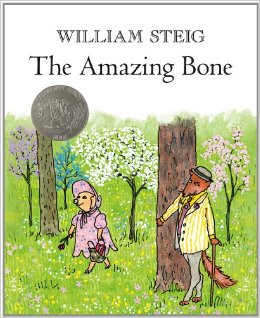

Banned Book Week Is Barely in the Rear View Mirror !
Observing Banned Book Week with “The Amazing Bone” by William Steig
The American Library Association, American Booksellers Association, American Society of Journalists and Authors and the National Council of Teachers of English are among those groups sponsored the recent observation and focus on censorship in reading, via “Banned Book Week” from September 27th to October 3rd. 2020. It is also endorsed by The Center for the Book in the Library of Congress.
A friend of mine told me our local library is featuring books on the list this week. Some “classic” reads are on this list, and it’s pretty hard to fathom how they ever made it on the list in whatever places they are banned.
If you check out the lists of links that I have provided, you will see there are a plethora of picture books and novels that have either been “challenged” or “banned” from libraries or schools because they “offend” the tastes of someone in the culture.
I read the difference between a “challenge” and a “ban” as it refers to a book, according to the American Library Association. A challenge is “an attempt to remove or restrict materials based upon the objections of a person or group.” Apparently this does not involve a mere point of view.
And a “ban” is the actual removal of the materials that are “challenged”.
And as the ALA asserts, these actions may be undertaken with the best of intentions and that is, to “protect others, frequently children – from difficult ideas and information.”
Parents rightfully can be very vocal about what is required reading for their children when it seemingly goes against their sense of what children of a certain age should be reading. And as a result School Boards and libraries are lobbied to either limit access to the offenders or ban them outright.
I am not going to get into a polemic on the right or wrong of this issue.
That is an issue for parents to debate and decide for their own children as to what they read or do not read.
But, I do want to put forth for careful consideration, one picture book that has been “challenged” in the past, as a model for what can and does happen.
It is a favorite of mine and of my now-grown daughters. The author is writer/illustrator William Steig, renowned for his illustrations in “The New Yorker.” He began a career in picture book writing in his 60’s; and that was his age, and not the decade!
And what a career it was.
His insightful drawings, brilliant use of vocabulary (“odoriferous wretch” – a term used to describe a villain in “The Amazing Bone”), and his imaginative narratives, filled with kind, caring, despairing, noble at times, silly, wily, pragmatic, and very human animals, are nothing sort of amazingly unique – and real.
In “The Amazing Bone,” life hums along on a beautiful spring day for a pig named Pearl. It opens in an everyday sort of way, until she happens upon a bone that talks in any language and can imitate any sound. The bone can also make magical things happen when all seems hopeless.
An easy bond of friendship is formed between the two, yet danger lurks unexpectedly and is resolved by the bone! He himself is unaware of his amazing powers; that is, until he is forced to use them!
As the “unexpected” appears in the form of a smooth talking, lavender lapel-filled, and nattily dressed fox, the bone, using words and phrases that he intuited fleetingly from a witch, such as “Scraboonit” and “Adoonish ishgoolak,” it soon whittles the fox down to minuscule size – with words!
I guess what I want to say, and perhaps what William Steig hinted at in “The Amazing Bone,” is that words are very powerful things, and when they find their way into books, they are amazingly powerful – like those in “The Amazing Bone.”
And, as a parent, what a shame it would have been for my girls not to have read, and reread that book that lives in their “quotable memories” today.
Please give this “challenged” book a read as well as Steig’s “Sylvester and the Magic Pebble” that won the Caldecott Award in 1970 for “Best Picture Book of the Year”, given by The American Library Association, as well as his “Amos and Boris” and “Dr. De Soto,” that are but a sampling of his many wonderful picture books contributions.
Please decide for yourself the value of books on banned lists, and if they deserve a place in your child’s repertoire of reading. And while we are talking about lists, “The Amazing Bone” was on quite a few, and here they are:
1977 Caldecott Honor Book
1976 New York Times Book Review Notable Children’s Book of the Year
and Outstanding Book of the Year.
1976 Boston Globe – “Horn Book” Awards Honor Book for Picture Books
And so, to the naysayers of William Steig’s, “The Amazing Bone,” I quote from the words of the amazing bone to the fox:
Scraboonit!!!
http://www.ala.org/bbooks/frequentlychallengedbooks/classics
